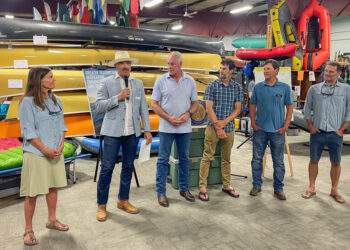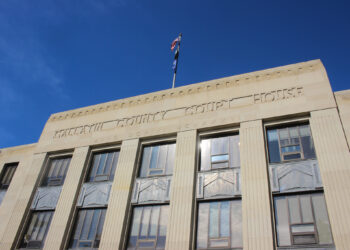By Todd Wilkinson
EBS Columnist
Amid the steady rise of intensifying outdoor recreation pressure on public lands in Greater Yellowstone, a number of questions rise to the surface. Here’s one: How might this pressure affect grizzly bears?
A few years ago, researchers in Yellowstone wanted to know how recreationists heading into the backcountry, far from the crowded highway corridors of America’s first national park, affected grizzly behavior. They gleaned insights as part of a multiyear effort examining whether “Bear Management Units”—those rarest of areas in the Greater Yellowstone Ecosystem where public access is sometimes totally restricted—fulfill their purpose of providing habitat security for grizzlies.
The peer-reviewed Yellowstone study on grizzly bears has a long title: “Grizzly Bear and Human Interaction in Yellowstone National Park: An Evaluation of Bear Management Areas.” Its findings, published in the Journal of Wildlife Management in 2013, may serve as a solid baseline reference point for discussion and wider extrapolation.
A healthy grizzly population relies foremost upon quality habitat in order to persist. By “habitat,” it means secure, stable terrain that has ample varieties of natural nutritious food to sustain bears while they are active and in hibernation; terrain that keeps them healthy enough to reproduce, doesn’t have a lot of extenuating circumstances beyond normal risks that cause bears to die or be removed, and enables their movement because individual bears have massive home ranges.
Conservation biologists often refer to grizzlies as both a bellwether and an “umbrella” species. Protected habitat that is good for perpetuating bear survival is also beneficial to hundreds of other native species, including big game animals prized by hunters along with fish and game agencies.
Bear Management Units were first created in 1982 as part of the Yellowstone National Park Grizzly Bear Management Environmental Impact Statement. At the time, grizzlies were being killed or forcibly removed (many because of poor human trash-storage methods, poaching and clashes with livestock) at a rate that was exceeding reproduction. The lowest estimate was just 136—most inhabiting Yellowstone—and it made wildlife managers realize they needed to take dramatic action.
Scientists worried that if backcountry areas could not provide enough adequate secure habitat to accommodate the natural foraging needs of grizzlies that the health of the population would be in serious jeopardy.
The Yellowstone study was centered in six of the park’s 16 BMUs, among them the Two Ocean Pass area in the far southern tier of Yellowstone considered one of the most remote geographical locations, in terms of distance from a road, in the Lower 48.
Carried out over a couple years, researchers deployed 18 radio collars emitting GPS signals on 14 grizzlies, including 10 male and four female bears. In parallel, researchers enlisted recreationists to tote signal-emitting devices in their backpacks and horse paniers so their movements could be tracked.
As data rolled in, researchers compared how grizzlies used habitat when BMUs were closed off to human access and how bears altered their behavior in the landscape when people moved through or camped. What they found is that even relatively few numbers of people, or low intensity of use, displace bears living in some of the most isolated parts of Yellowstone.
Grizzlies were twice as likely to be present in areas when human access was restricted. When people were allowed to enter a stretch of backcountry, bears were more than twice as likely to be present only when humans were inactive, i.e., at night when campers were asleep. The data demonstrates that human recreational activity displaces bears from habitat where they would otherwise want to be.
“This suggests an avoidance response of bears to people. This is noteworthy considering the low human use in our study area,” the authors wrote, and added: “Our study provides evidence for the utility of management closures designed to protect a threatened species in a well-visited park. Our approach can be reapplied by managers interested in balancing wildlife conservation and human recreation.”
Poignant is that the study offers insight into grizzly behavior not only when there is no human disruption but, again, for knowing what happens when disruption levels are small compared to more intense levels of human activity happening in multiple use or popular wilderness areas in national forests. It has many potential implications for pondering bear habitat security in the center of the ecosystem if numbers of human users rise and what higher levels of recreation pressure mean and could mean for bears and other wildlife outside the national parks.
Of the findings in Yellowstone, the authors wrote: “Since this was an observational study, we can only describe an association between human and bear movement behavior. However, other research has detected similar patterns.” They noted [again, remember this was written a decade ago when overall visitation to Yellowstone was much lower and not extending robustly across more months as today]: “Park visitation is low in spring and early summer, high in mid-summer, and low in autumn. Visitation trends may influence bear movement behavior because they often avoid busy developed areas and occupied recreation trails.”
In recent years, Forest Service personnel on most national forests in Greater Yellowstone have acknowledged a problem exists with unapproved “user-created trails.” These can be trails where recreationists usurped wildlife paths, mechanized recreationists ride off trail, dispersed camping in prime wildlife habitat, or inadequate staffing to deal with impacts and enforce regulations prohibiting those activities.
Neither public lands nor wildlife inhabiting them exist as islands unto themselves, nor in isolation from intensifying patterns taking hold on private lands. Species populations suffer more and disappear faster in fragmented landscapes.
Todd Wilkinson is the founder of Bozeman-based Mountain Journal and a correspondent for National Geographic. He authored the book “Grizzlies of Pilgrim Creek,” featuring photography by famed wildlife photographer Thomas D. Mangelsen, about Grizzly Bear 399. Wilkinson’s new book, “Ripple Effects,” is now available on mountainjournal.org.














